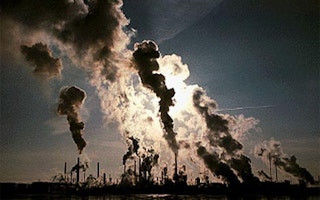China spurred a jump in global carbon dioxide (CO2) emissions to their highest ever recorded level in 2011, offsetting falls in the United States and Europe, the International Energy Agency (IEA) said on Thursday.
CO2 emissions rose by 3.2 percent last year to 31.6 billion metric tons (34.83 billion tons), preliminary estimates from the Paris-based IEA showed.
China, the world’s biggest emitter of CO2, made the largest contribution to the global rise, its emissions increasing by 9.3 percent, the body said, driven mainly by higher coal use.
“When I look at this data, the trend is perfectly in line with a temperature increase of 6 degrees Celsius (by 2050), which would have devastating consequences for the planet,” Fatih Birol, IEA’s chief economist told Reuters.
Scientists say ensuring global average temperatures this century do not rise more than 2 degrees Celsius above pre-industrial levels is needed to limit devastating climate effects like crop failure and melting glaciers.
They believe that is only possible if emission levels are kept to around 44 billion metric tons of CO2 equivalent in 2020.
Negotiators from over 180 nations are meeting in Bonn, Germany, until Friday to work towards getting a new global climate pact signed by 2015.
The aim is to ensure ambitious emissions cuts are made after the Kyoto Protocol expires at the end of this year.
Procedural wrangling and a reluctance to raise ambitions to cut emissions due to economic constraints is threatening progress, however.
“I think it would be unrealistic to think that there will be major breakthroughs very soon,” Birol said.
“Climate change is sliding down in the international policy agenda, which is definitely a worrying trend.”
Shale gas helped US
Birol cited cutting fossil fuel subsidies, boosting energy efficiency and moving away from coal as “buttons to push” for world governments to help meet emission targets.
He also warned about the impact of phasing out nuclear power output after the Fukushima accident in Japan, which helped push Japanese carbon emissions 2.4 percent higher in 2011.
“In Japan, the rise is almost exclusively due to higher fossil fuel use. This is a very important indication of what could happen if there was a move away from nuclear energy in other countries,” he said.
In China, CO2 emissions per unit of GDP - or its carbon intensity - fell by 15 percent between 2005 and 2011, the IEA said, suggesting the world’s second-largest economy was finding less carbon-consuming ways to fuel growth.
In the United States, the world’s second-biggest CO2 emitter, a switch to natural gas from coal in power plants, a slower economy and a mild winter helped cut emissions by 1.7 percent.
“The replacement of coal by shale gas is a key factor and what happened in the US could very well happen in China and other countries and could definitely help in reducing CO2 emissions,” the IEA economist said.
In Europe, a relatively warm winter combined with sluggish growth helped cut emissions by 1.9 percent.
Asked about prospects for global carbon emissions in 2012, Birol said:
“It would come as a very, very big surprise to me if we saw a significant decline in CO2 emissions.”










